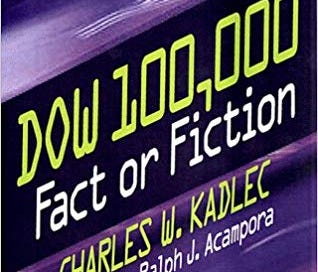Dow 100,000
Early in the year, the Dow Jones Industrial Average closed in on 30,000 points. Due to the Coronavirus outbreak, it didn’t manage to break through this level, but it is only a matter of time until it does. As has become custom whenever the Dow approaches a round number, people dug up their old stories about the book Dow 36,000. Back in 1999, the authors claimed that the Dow was not overvalued and would quadruple in the coming years. Of course, the book became a public embarrassment once the bubble burst three months later.
But alas, as the Dow grinds higher, the embarrassment becomes increasingly mixed with an attitude of “I told you so” in the sense that if you just wait long enough, stocks will do great. Stocks for the long run is an adage that has become a cliché, though there is obviously some truth to it. Stocks outperform bonds in the long run and the range of returns you can expect from stocks becomes more and more attractive the longer you stay invested.
The chart below shows the returns of the Dow Jones Industrial average for different investment horizons (based on annual returns going back to 1900). Note that these returns are without dividends since the Dow is a price index and not a total return index. If you are invested in the Dow Jones for just one year, anything between -53% and +82% was possible. If you invested in the Dow for 20 years, anything between 0.6% and 13.1% per year would have been possible. Add to that the dividends you earned along the way and the Dow would have beaten inflation (and Treasuries) over that time horizon. And as the investment horizon becomes longer, the range of possible outcomes becomes smaller. Hence, stocks become less risky in the long run.
The uncertainty of future returns declines with longer investment horizon

Source: Bloomberg.
Or do they?
Thanks to the wonders of mean reversion, the range of realised returns for stock markets narrows as the investment horizon increases. But as Paul Samuelson already noted in 1966, that does not mean that your risk declines. In fact, if we use the same data as in the chart above and plot the evolution of one Dollar invested in the Dow Jones, you can easily see that the range of outcomes increases as the investment horizon increases. Hence investment risk measured in terms of what really matters, namely ending wealth, increases over time. This is simply a reflection of the fact that mean reversion doesn’t happen fast enough to overcome the compound effect of extreme returns early on in your investment career. If you start your investment career shortly before the burst of the tech bubble as I have, you will experience large losses early on and you will forever trail another investor who started his investment career at the beginning of the bull market twenty years earlier (thanks boomers).
The uncertainty of future wealth increases with investment horizon

Source: Bloomberg.
But while the chart above can be used to estimate the range of outcomes for your investments over time, you can also use it to estimate the time it takes for an index to double, triple or quadruple.
Back in 1999 the book Dow 36,000 predicted the index would quadruple. I have never read the book, so I don’t even know if they made a forecast over what time frame the Dow would quadruple, but the chart below shows that based on historic experience, it should take somewhere between 8 and 54 years until this happened. It’s been 20 years since the prediction was made and if we reach Dow 36,000 in the next five years then we are bang on track to the median expected outcome. The Dow should quadruple roughly every 25 years or so.
When will we see Dow 100,000?

Source: Bloomberg.
Which brings me to another book published in 1999 called Dow 100,000. To get to that level, the Dow would have to quadruple from today’s levels and the chart above tells me that this will take somewhere between 8 and 54 years.
Thus, I predict the Dow Jones Industrial Average will reach 100,000 points, sometime between 2028 and 2073. Am I becoming an investment legend now?
It’s just a matter of time…

Source: Kadlec (1999).



